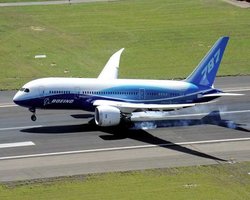Boeing production of its 787 Dreamliner aircraft is to be reduced to 1.5 airplanes per month from its current 1.75.
The company says this is due to lower demand for large passenger and freighter aircraft.
Eric Lindblad, vice president and general manager, 747 Program, Boeing Commercial Airplanes, said:
“This production adjustment better aligns us with near-term demand while stabilizing our production flow, and better positions the program to offer the 747-8’s compelling economics and performance when the market recovers. Although we are making a small adjustment to our production rate, it doesn’t change our confidence in the 747-8 or our commitment to the program.”
This new rate of Boeing production of 1.5 new Dreamliners each month will continue until the end of 2015.
In an online communiqué, the company says it expects long-term average growth in the cargo market to start picking up again next year.
Boeing forecasters predict that worldwide demand for 760 large airplanes, including the 747-8 over the next two decades will be worth approximately $280 billion.
According to Boeing, the 747-8 family provides airlines with:
- Double-digit improvements in fuel efficiency.
- Improvements in operating costs and emissions.
- 30% less noise.
- More capacity.
With current orders, Boeing production secured for many months
Boeing has received 107 orders for the Dreamliner (747-8) aircraft so far, including cargo and passenger versions. Fifty-six have been delivered.
So far, the company has not netted any new sales for the Dreamliner this year. Some people wonder whether a Boeing production of just 1.5 per month might try customers’ patience, while others say that this will not be a problem as demand has dropped.
Boeing added “The first delivery at the new production rate is expected in early 2014. The production rate change is not expected to have a significant financial impact.”
Boeing’s market outlook – 2013-2032
According to a global survey, over the next thirty years Boeing expects global demand for new airplanes will total 35,280 aircraft, worth $4.8 trillion.
Forty-one percent (14,350) of these airplanes are expected to be bought to replace older, less efficient ones, thus reducing the cost of air travel and lowering carbon emissions.
Fleet demand will make up the remaining 59% (20,930), stimulating growth in emerging markets.
Seventy percent of new deliveries (24,670 airplanes) will be single-aisle aircraft “reflecting growth in emerging markets such as China, and the continued expansion of low-cost carriers throughout the world.”
Widebody aircraft share of the market is expected to grow from its current 23% to 24%. “The 8,590 new widebody airplanes will allow airlines to continue expansion into more international markets.”
2013 – the year of glitches for Boeing’s Dreamliner
Throughout most of 2013 several airlines have complained of technical problems and fires in the 787 Dreamliners. Last week Japan Airlines had to turn around two airplanes in mid flight because of technical problems.
Japan airlines, which has been complaining of Dreamliner glitches again and again, surprised the market last week by announcing the purchase of $9.5 billions’ worth of Airbus A350 passenger airplanes. Boeing has historically completely dominated the market in Japan.
In the deal with Airbus, Boeing’s European rival, Japan Airlines’ order included eighteen A350-900s and thirteen A350-1000s.

